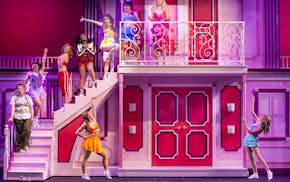We don't expect beauty from gas stations, but we used to.
When stations started popping up in the 1920s, they chose historical styles, since that was the architectural vernacular of the era. A Spanish-style building with tiled roofs, a mock Tudor cottage, a bit of classical style as if you were feeding oats to your chariot horse instead of gas to your metal steed.
After World War II, a new style emerged: white and minimalistic.
All the big brands — Gulf, Texaco, Standard, Esso — went with the same style and shape, almost as if it was a Platonic ideal. Two big bays for service, a small office on the corner with stacks of oil cans and batteries and belts and filters, and two bathrooms around the corner. If it weren't for the big sign on a pole in the corner of the lot, you might not have known which brand you were patronizing.
According to the ad campaign of the times, your family would be dressed entirely in white. The attendant who came out to pump your fuel and check your oil: spotless white, unmarred by oil or grease. The gas station itself: a gleaming box of alabaster perfection. It was a vision of prosperity and, just as important, cleanliness: You wouldn't mar your clothes with oil, the bathrooms would be antiseptic and pristine.
The ads made getting gas look like a holy ritual, with Dad solemnly studying an unfolded manuscript devoted to the prophecies of St. Rand and St. McNally.
Eventually, though, new styles would compete for motorists' attention.
In the 1960s, Phillips 66 introduced an audacious "batwing" canopy over the pump islands, a V-shaped overhang that pointed to the sky. A few can still be found around the city, but few, if any, are still Phillips stations.
Another style from the post-white-box era was Texaco's Matawan design, a late 1960s style named for the New Jersey town where it was first built. The details varied from station to station, but they were characterized by fake jumbled rock veneer and colonial-era light fixtures. It was an ugly and incoherent look, and it infected nearly every Texaco station in the country.
Just because it was a regrettable look doesn't mean it should be exterminated, though. One surviving example in Minneapolis, at 54th Street and Penn Avenue S., has been remodeled into a modernistic dentist office, but in the back, the old faux stone remains.
It might be one of the oldest unmolested postwar facades outside of downtown.
Perhaps the most unique gas station in the state, if not the country, can be found in Cloquet: the Lindholm Oil Co. station, designed by Frank Lloyd Wright.
The initial design was made in 1930s for Broadacre City, a project that never happened. Wright dusted it off three decades later for a Cloquet client, and the station opened in 1958, looking like a relic from a sci-fi pulp mag.
Wright's design didn't end up being a turning point for gas stations. For decades, the white box reigned. In a way, though, Wright's ideas triumphed after all.
He intended the station to be a social center for the community as well as utilitarian gas-and-go facility. This would have been an absurd idea to apply to the white boxes. Oh, some locals might hang around the garage, have a Coke and chat with the mechanic on a hot day, but the old gas stations were not places where people would congregate.
Today, though, the gas station plays a different role.
It doesn't have two bays with hydraulic lifts. It has a wall of coolers. It doesn't have a neatly stacked pyramid of oil cans. It has a shelf of pop and bread. It's more of a grocery store than a gas station, and sometimes a small cafe. In small towns, the gas station is often the only place to get a fresh pizza or a sandwich, and if there's some tables and chairs, well, that's exactly what Wright wanted.
Contemporary gas stations don't add much visual interest, but that's often a luxury. The idea that a gas station can be ugly or beautiful seems outside of the usual conversations about urban design. We expect them to be unadorned and functional. There's no reason to expect them to look good.
But we once did, and we should again.

For 'Legally Blonde' star, 'being underestimated is her secret superpower'

Restaurant openings and closings in the Twin Cities

Minnesota's Amy Thielen launches old-fashioned radio show for food lovers
Yuen: How success has pushed Minnesotans off sidelines in trans athlete debate

